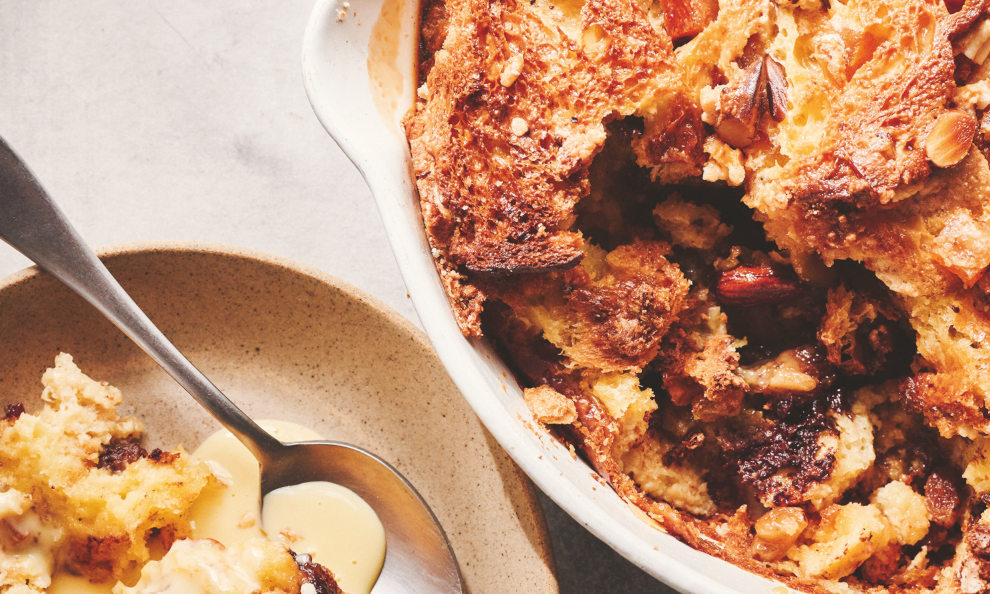
Marcus Wareing’s Panettone Bread & Butter Pudding
Marcus Wareing’s Panettone Bread & Butter Pudding
A delicious way to use up leftover panettone
Serves 6
Ingredients
• 750g panettone, cut into thick slices
• 50g butter, melted
• 50g dark chocolate, roughly chopped
• 50g sultanas
• 500ml double cream
• 5 eggs
• 100g caster sugar
Method
1. Brush one side of each slice of panettone with the melted butter.
2. Arrange half of the buttered panettone in a single layer buttered side up in a medium casserole dish, then sprinkle over the dark chocolate and sultanas. Arrange the second half of the sliced panettone as the final layer.
3. Pour the double cream into a small saucepan and slowly bring to the boil over a medium heat, removing it before it reaches boiling point. Whisk the eggs and sugar together in a heatproof bowl until smooth, then pour in a third of the hot cream, whisking continuously and slowing down or stopping adding the cream for a moment, if required, as you do not want to cook the eggs. Continue until all the cream is incorporated into the egg mixture.
4. Pour the cream mixture evenly over the layered panettone and allow the liquid to soak into the bread for 30 minutes.
5. Preheat the oven to 160°C/140°C fan/ gas 3.
6. Place the casserole dish in a large roasting tray that has been slightly filled with water – the water should come about three-quarters of the way up the casserole dish (no less than halfway). Cooking the pudding in a water bath like this helps it to cook as the top browns.
7. Place the tray containing the casserole dish in the oven and bake for 30-35 minutes until the top of the pudding is golden brown and the centre has set firm. Serve with cream or Marcus’ recipe for marmalade custard…
Marmalade Custard
• 300ml milk
• 300ml double cream
• 6 egg yolks
• 100g caster sugar
• 2 tbsp fine-cut marmalade
grated zest of 1 orange
50ml Grand Marnier or orange liqueur (optional)
Method
- While the pudding is in the oven, make the custard. Combine the milk and cream in a saucepan and slowly bring to the boil over a medium heat.
- Whisk the egg yolks and sugar together in a heatproof bowl until smooth. Once the cream and milk mixture has almost reached boiling point, slowly pour a third of it into the eggs, whisking continuously and slowing down or stopping adding the hot cream for a moment if required, as you do not want to cook the eggs. Continue until all the hot cream mixture is incorporated into the egg mixture. It’s important to stir well at this stage to ensure that all the sugar dissolves into the liquid.
- Rinse out the pan, pour the custard back into it and return to a low heat. Cook the custard for 4-5 minutes, stirring constantly and gently with a spatula or spoon, until the first bubble rises to the surface as it starts to approach boiling point. You will know the custard is thick enough when you test it with the spoon or spatula – coat the back of the spoon or spatula and run your finger down the mixture. If it’s thick enough the line you’ve made should remain. Keep stirring so that it doesn’t catch on the bottom of the pan and burn. To be extra precise, check the mixture with a thermometer – it should reach exactly 82°C. Take care not to boil the custard as the egg yolks will scramble. Once the custard is cooked, remove from the heat and whisk through the marmalade, orange zest and orange liqueur (if using).
- To serve, divide the bread and butter pudding among serving bowls, then ladle over the hot marmalade custard.
TIP: Leftover egg whites can be frozen in an ice-cube tray to make individual portions. Transfer, once frozen, to a freezable container or bag, then take the whites out as needed and defrost to use in meringues, sponges or cocktails.
Extracted from Marcus’ Kitchen, HarperCollins.






